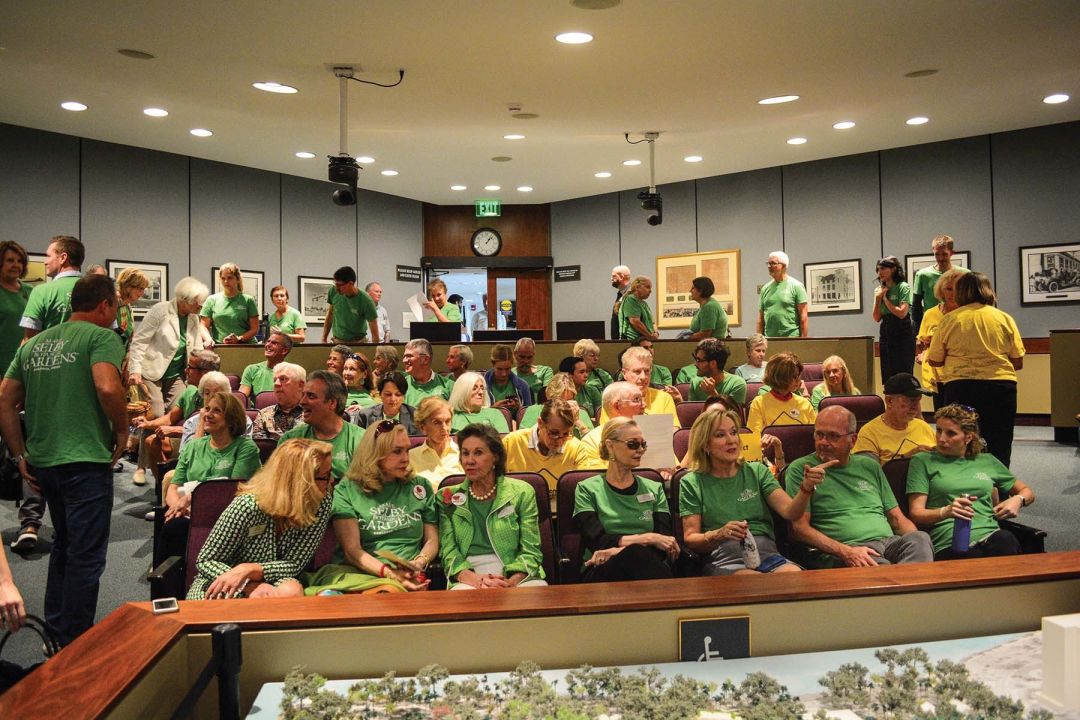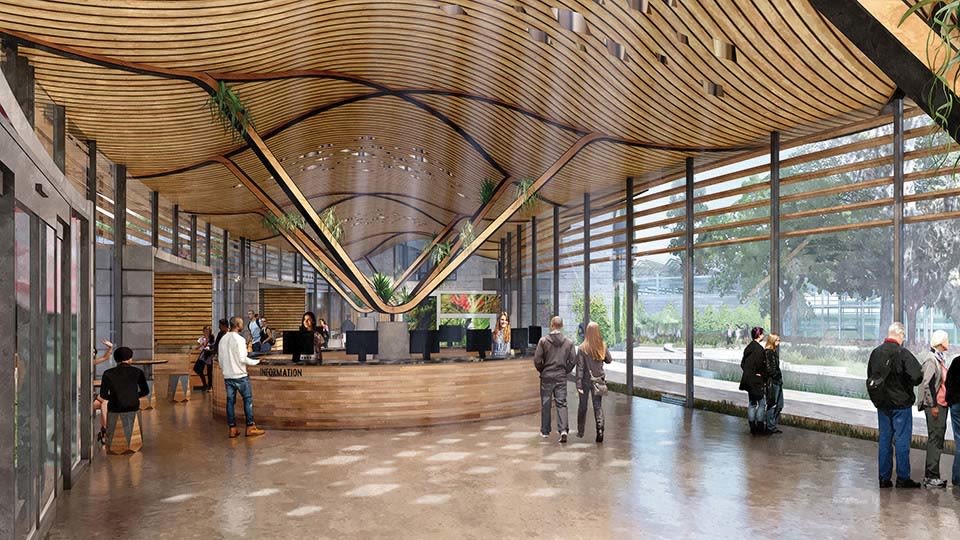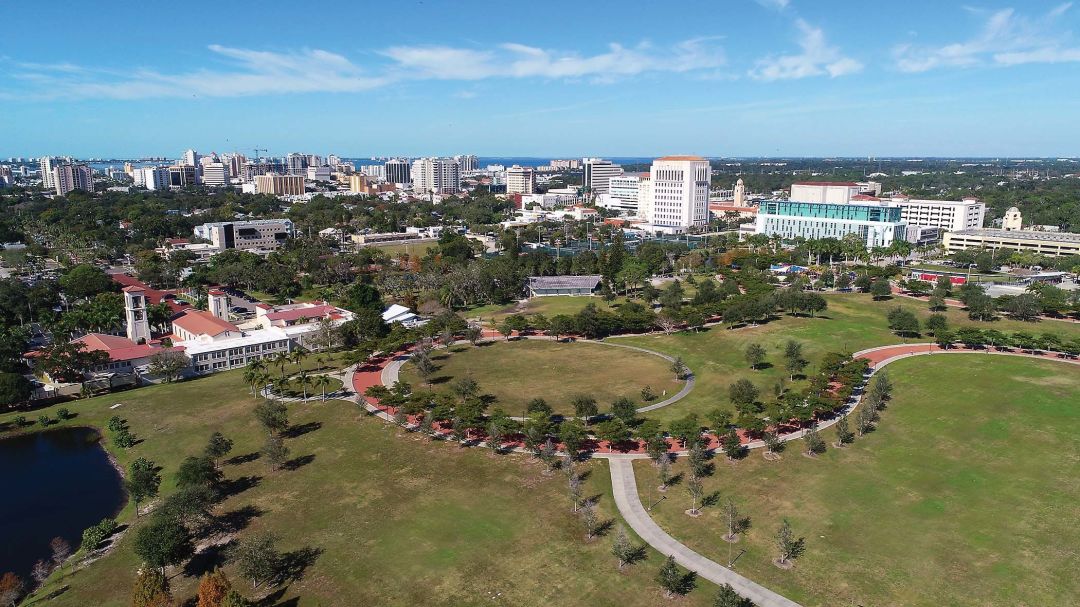
Inside the Bitter Fight for the Future of Sarasota
Last fall, moments before the battle began, nervous chatter hovered above the crowd at City Hall. Half the seats in the room were taken by dozens of men and women in the green T-shirts favored by supporters and employees of Marie Selby Botanical Gardens. The other seats were taken by their opponents, the men and women of Selling Out Selby, their yellow T-shirts emblazoned with the slogan, “Flowers Not Towers.”
The object of the day’s fight was on display near the center of the City Commission chamber. There, on a table, sat a three-dimensional model depicting Selby Gardens’ original master site plan, a $92 million upgrade that had been in the works for nearly three years. To complete the makeover, Selby Gardens had to convince four out of five commissioners to alter the city’s comprehensive plan, as well as its zoning code.

Supporters and opponents of Marie Selby Botanical Gardens’ master site plan in the City Commission chamber last fall.
Image: Courtesy Selby Gardens
According to Selby president and chief executive officer Jennifer Rominiecki, the organization has outgrown its current facilities and can’t survive without a major overhaul. Nearby residents, however, objected to the five-story parking garage with a rooftop restaurant planned for the northeastern section of the Selby property. They argued the changes would result in an uptick in traffic and noise that would spoil the beauty of some of Sarasota’s oldest neighborhoods. The long-simmering conflict filled the City Commission chamber.
The gavel came down, and the battle stretched over almost 14 hours across two days. Selby representatives, backed by city staff who recommended approval for the gardens’ plan, laid out their justification for the new facility, while neighbors and former elected officials lined up to have their say. Former City Commissioner Ken Shelin blasted the “absurd” process that led to the protracted fight and blamed “unhappy people who show up at planning board and City Commission public meetings” for stifling Selby’s growth.
For Joan Schwartz, who lives near Selby Gardens, larger issues were at stake. “I’m here because our neighborhoods are threatened, and when our neighborhoods are threatened, our homes are threatened, and when our homes are threatened, our lives and our health are threatened,” she testified. Approving Selby’s plan would lead to nothing less than the “annihilation of the character of one of Sarasota’s most charming and peaceful legacy neighborhoods,” she added, charging that Selby’s “unscrupulous” leaders violated “all the rules of human decency” in their campaign for the project. “Residents’ lives matter,” Schwartz said. “At least, they should.” At the end of the second day, Selby’s proposal was shot down in a 3-2 vote.

A rendering of Selby’s original proposed visitors' center.
Image: Courtesy Selby Gardens
The tense confrontation wasn’t just a dispute over how high the gardens’ new parking garage could go or where trucks delivering food to the restaurant would pull in. It was part of a broader fight over the future of Sarasota, a skirmish that has engulfed arts groups and attractions as well as neighborhood associations and fired-up activists. Call them the T-shirt wars, a series of hard-fought conflicts in which you can tell by the color of someone’s T-shirt whether that person is an ally or a mortal enemy.
The simple reason for the tension is that, as any glance at the downtown skyline will tell you, Sarasota is growing. According to U.S. Census Bureau statistics, the City of Sarasota’s population rose from just over 52,000 in 2008 to nearly 57,000 in 2017, a 9.4 percent increase. Population figures have grown even more sharply in surrounding areas. Between 2008 and 2017, Sarasota County’s population shot up from just over 371,000 to more than 419,000, a 12.9 percent spike. And those are just the people who live here. More than 2.7 million people visited Sarasota County in the county’s 2018 fiscal year, a 34.2 percent surge from the 2014 total. (Most likely that number would have been higher, if not for 2018’s catastrophic outbreak of red tide.)
T-shirt wars are not unique, says City Manager Tom Barwin, who worked in municipal government in Oak Park, Illinois, and Ferndale, Michigan, before being hired by Sarasota in 2012. “Land-use decisions have become pitched battles in many, if not most, nice communities across the country,” Barwin says.
The key word is “nice.” Sarasota’s natural beauty and cultural offerings are major reasons why people like living and visiting here, and the recent influx of new residents, snowbirds and tourists has led to rising housing costs and strains on existing infrastructure—everything from overcrowded roads and bridges to bursting-at-the-seams cultural institutions and tourist attractions.
According to Rominiecki, around 60 times each year Selby must turn away visitors because it lacks enough parking spots, one of the major motivations for the gardens’ redevelopment proposal. Rominiecki says the gardens, sandwiched between Sarasota Bay, existing homes and U.S. 41, must either redevelop its property or pick up and move its operations altogether. “The status quo is not an option,” she says.
The Sarasota Orchestra, meanwhile, performs more than 100 concerts a year, employs 315 people and manages a $10 million budget, but because it lacks a suitable dedicated concert venue, it must work with five partner organizations around the area to put on its shows. That cramps its ability to increase its programming. Last year, when the orchestra unveiled a “vision” for a new permanent music hall to be located in downtown’s Payne Park, residents objected to the use of park space for the facility, and tennis players protested moving the park’s tennis courts. They hastily organized to create Preserve Payne Park and printed up yellow T-shirts with a new logo. At a meeting at which the final vote wasn’t taken until 1:30 a.m., the City Commission denied the orchestra’s vision.
Other organizations have already made plans to grow outside Sarasota’s city limits. While Mote Marine Laboratory & Aquarium will hang onto its current City Island home, the organization is planning to build its new $130 million, 110,000-square-foot aquarium on property owned by Sarasota County in Nathan Benderson Park. The Players, the city’s oldest performing arts organization, sold its longtime home near the bayfront for $9.5 million in 2018 and is building a new facility in Lakewood Ranch’s Waterside District with a 480-seat auditorium, a 100-seat black box theater and a 100-seat cabaret space. The threat of losing other cultural institutions hangs over every decision the city makes on controversial issues like the Selby Gardens and Sarasota Orchestra plans.
Could Selby Gardens, which has been a part of downtown Sarasota for 45 years, really relocate to Lakewood Ranch? Rumors to that effect made the rounds just days after the City Commission’s vote last November. “We are currently evaluating all options for Selby Gardens’ future,” Rominiecki said. In January, however, Selby announced details of a second master plan, scaled down so that it doesn't require a change to the city's comprehensive plan. According to a press release, the gardens' proposed parking structure will be reduced in height by 40 percent, and the restaurant, originally planned for the parking garage rooftop, will be located on the ground floor, with 110 seats instead of 185.
Tension over development is nothing new in Sarasota, of course, and many veterans of the T-shirt wars point back to hard-fought victories and losses from previous decades as a way of suggesting that today’s headline-grabbing squabbles are no more vicious. But others charge that today’s fights are nastier than ever. Social media apps like Facebook and Nextdoor have made it simple to reach out to neighbors to organize, and it’s a cinch these days to build a website and record and post YouTube clips arguing your points. While it’s never been easier to become an engaged citizen, the downside is that it’s also never been easier to spread misinformation, even if accidentally.
Barwin says the rise of digital and social media has dramatically changed the tone of civic debates during his tenure as city manager. “We can find examples where individuals will hear a rumor, or hear about something, and maybe see something in writing somewhere, and within 24 hours, they have adopted a position, begun to organize opposition, started a petition drive and, in some cases, even lawyered up,” he says.
Sarasota Orchestra president and chief executive officer Joseph McKenna says digital tools are often used to shut down debate, rather than encourage it. “We can communicate about a lot of things and say nothing,” he says. “There’s a lot of noise in the world today about all kinds of everything, and in the midst of the noise it’s very hard for visionary, forward-thinking things to take shape and move forward.”
Selby Gardens unveiled its master plan in October 2017. Rominiecki says, at first, the conversation with nearby neighborhoods groups was civil. “I had no idea the opposition we’d end up facing,” she says. She says the debate changed after Jan. 28, 2019, when Selby issued a press release announcing that it had raised $31.5 million out of the $42.5 million needed to complete phase one of the master plan. While before, the plan might have seemed like a far-off, fanciful idea that might never get built, all of a sudden it became clear that Selby was close to hitting its fundraising targets. “That’s when the vocal opposition began,” Rominiecki says.
Former City Commissioner Susan Chapman was one of the leaders of the opposition. She says the issue is simple: The city’s comprehensive plan was created to guide how the city should grow, and the city shouldn’t alter that plan unless there’s an extraordinary reason to do so. The comprehensive plan’s future land use map designates Selby’s property as “Community Office/Institutional,” which means it should serve as a “medium intensity” buffer between single-family homes and busy commercial areas. Selby was at first asking the city to change its classification to “Metropolitan-Regional,” reserved for “multiple story buildings” and “high traffic generators.” If Selby wants to grow, Chapman argues, “they should follow the law.”
Rominiecki says Selby ramped up its messaging campaign when she began seeing “false information circulated.” The gardens added a “Myths vs. Facts” page to its website, and Rominiecki recorded a series of videos “busting the myths” about the plan. Rominiecki says the divisive state of national politics has filtered down into local issues. “The incivility reached new heights,” Rominiecki says.
Chapman agrees, but she blames Selby. “We didn’t fight with them,” she says. “They fought with us.” According to Chapman, activists were harassed while putting out yard signs, their homes were photographed by Selby supporters and they were vilified as NIMBYs standing in Selby’s way. “Trump’s techniques work,” Chapman says. She calls Selby’s marketing campaign for the project “overwhelming.”
Blame also falls on Barwin, says Chapman. “The city manager is creating false expectations by encouraging projects that may not be approved by the City Commission,” she says. Groups like Selby and the orchestra are led to believe that their plans will be “embraced by the public” and then are “shocked and appalled” when residents don’t support them. “It’s not the role of the city manager to be a visionary,” she says. “I think he needs to do some soul-searching and reevaluate what his role is.”
Mayor Jen Ahearn-Koch, who voted against the Selby and orchestra proposals, says there’s often not enough conversation between all the parties involved in or affected by a new project until too late in the approval process. Developers, neighborhood groups, city staff, elected officials and the public at large often have conflicting priorities, and those disagreements sometimes aren’t hashed out until a public meeting before the City Commission, which must make an up or down vote. (That wasn’t the case with Selby, which, according to Rominiecki, held 67 community meetings before the City Commission showdown.)
Ahearn-Koch is often opposed to what’s known as “administrative approval.” That’s a process by which city staff can sometimes OK new construction without public input. She thinks changing those processes would eliminate some of the tension fueling the T-shirt wars. “That would help a lot with these kinds of situations where the community is brought in at the 11th hour,” she says. “Better communication is the key to everything.”

Citizens successfully opposed Payne Park as the site for the Sarasota Orchestra’s new concert hall.
Image: Chad Spencer
McKenna says what disappointed him the most when the City Commission voted against the orchestra’s Payne Park concept was that it killed any possibility of exploring the idea further. The orchestra had made a strategic decision to unveil what it called a “vision” for a music hall in Payne Park at a special City Commission meeting last February. There were no concrete plans for exactly where the facility might be located in the park or what its final shape might take. “All we were asking for was an opportunity to explore Payne Park,” McKenna says.
The orchestra has been working for months to come up with an alternate site for a future home. McKenna notified the city in January that it has not identified any viable sites within city limits. McKenna says the organization is being “disciplined” in how it selects a new site, but that it is working with a “high sense of urgency.” “There are real needs that the institution has,” he says, “and there are urgent needs for other music organizations for space.”
Chapman says fears of losing cultural institutions are overblown. “There is no culture crisis,” she says. Former City Commissioner Kelly Kirschner, another Selby master plan critic, agrees. “I reject any silly handwringing about the imminent doom of our arts and cultural organizations,” he says.
When asked whether other cultural institutions should be concerned about their future in the city, Barwin ticks off a list of several recent large-scale projects that have aroused little ire. The Westcoast Black Theatre Troupe just overhauled its campus, Ringling College of Art and Design opened its new Sarasota Art Museum in the old Sarasota High School, and the Legacy Trail is being extended into downtown Sarasota, among many other changes to the city’s landscape. “Overall, the picture is incredible and, I think, continues to improve,” Barwin says.
That doesn’t mean there won’t be future conflict. The Bay, the massive $100 million effort to remake north Sarasota’s waterfront, has so far won consistent support from the City Commission, but some residents objected to the demolition of the old G.Wiz building, and some who live in nearby condos are concerned about the size of the circular boardwalk that is part of Phase One, as well as a spike in traffic that may clog the entrances to their buildings along Boulevard of the Arts.
Paige Atkins lives in one of those bayfront condos. She says most of her neighbors support the project’s general outline. “The majority likes the idea of having a park next door,” she says. “We just want it done in a way that doesn’t result in potential safety issues.” Atkins credits the planners behind The Bay for making some changes to phase one after residents expressed concerns.
Still, one challenge for Atkins and her neighbors is that phase one is pitched as a “living, learning laboratory,” meaning planners will observe how people use the space and use that information to adjust their programming and alter their plans for the rest of the property. That leaves residents uneasy about what to expect once the park opens.
Bill Waddill, The Bay’s chief implementation officer, says the key is to build trust and credibility with neighbors. There have been more than 200 community meetings and dozens of public workshops devoted to The Bay in recent years, and 10,000 survey results have been tallied. Staff and board members operate in the sunshine, with meetings that are open to the public and a website that hosts staff presentations and meeting minutes.
Even so, it’s not unusual at a public meeting devoted to The Bay to hear someone in the audience mutter, “Bullshit,” about a part of Phase One he or she doesn’t like. Waddill hopes that by being transparent and responsive, The Bay will continue to move forward. “Trust takes a really long time to build,” Waddill says, “and it’s really easy to lose it if you’re not careful.”

The $100 million Bay project has City Commission support, but some neighboring condo residents have voiced concern.
Image: Courtesy Photo
If rapid growth in the wake of the Great Recession is what sparked the T-shirt wars, activists and developers should dig in for a long campaign. The University of Florida Bureau of Economic and Business Research estimates that Sarasota County will add at least 21,000 new residents by 2030. That’s the “low” estimate. The “high” projection shows the county’s population spiking by nearly 111,000.
“Sarasota is a very pleasant place,” says Chapman, “until it won’t be pleasant anymore.” Her wish list for Sarasota is pretty simple: plenty of green space, safe streets and sidewalks and peaceful neighborhoods. “You know what? I don’t want to fight all the time,” she says. “There is a point where you just want to live your life.”
Rominiecki, meanwhile, thinks that as Sarasota grows, it needs to embrace “visionary projects.” Speaking about Selby, but perhaps about the city as well, she says, “We can’t stay as we are.”
The time to begin planning for the city’s growth is now, McKenna emphasizes. “Communities that are alive are growing and evolving and changing,” he says. “There are ways to do that in a smart way. We have to be careful that we don’t work so hard to preserve something at the expense of a vibrant future.”
Featured illustration by Matthew Laznicka.
Editor’s Note: In the print version of this story, Sarasota Magazine erroneously attributed a statement to Selby Gardens’ Jennifer Rominiecki about President Trump. Rominiecki did not make any statements about the president. Instead, she said that the divisive state of national politics has filtered down into local issues. Sarasota Magazine regrets the error.